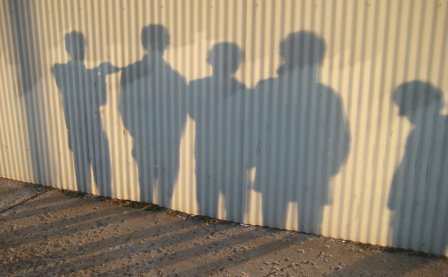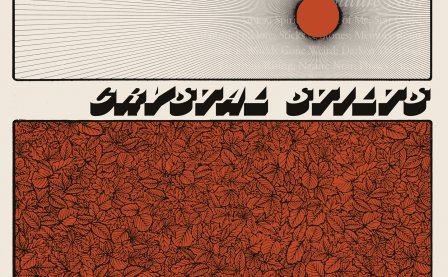In Love With Oblivion, the new album by Crystal Stilts, opens up like a runaway stagecoach. The first track, “Sycamore Tree,” cuts in with a country boom-chuck and then a sinister Duane Eddy riff. Over it all, lead singer Brad Hargett moans like a ghost rider in the sky, luring his lady friend to the sea for no good reason at all. By the time the organ arrives, leering and brash, you know these guys are just sick enough to make it all come off like fun. As we trek across these dark plains of sound, the manic bop of early rockabilly becomes the dark buzz of surf-rock psychedelia becomes the hip sleaze of States-side punk. Don’t mind the warning beep in the background; sinister American pop — whether it’s Johnny Cash or Jim Morrisson or Joey Ramone — never felt so good.
Too many references? Certainly, as with their 2008 effort Alight of Night, this band isn’t shy about its sources. In fact, when people try to describe the sound of the Stilts, they tend to fall back on pop arithmetic. I’ve heard the band described as 60s garage rock plus 80s jangle pop, or, better, The Velvet Underground plus Joy Division plus Spacemen 3, or, for an advanced student, Nuggets plus C86 plus Flying Nun. Of course, toss together some jangly guitars, tom-tom drums, a Hammond organ, and a heavily-reverb’d baritone, and it’s going to be hard to avoid comparisons. But Crystal Stilts have enough songwriting chops to stand out on their own, and as musicians they know how to synthesize their sources into something truly rich and strange. Indeed, despite the often perfunctory performances of its sources, this band is tight as hell, and its muscular rhythm section would carry almost any jaded listener across its repertoire.
Here, though, the group has shifted away from the lo-fi post-punk sound of earlier efforts to a more melodic blend of noise pop and garage rock. Whereas the last album came loaded with indie mystique, hinting at both underground rites and cosmic flights, the new one rides a dustier, grittier trail through the canyons of Americana. Mercifully, perhaps, the band sounds less like Joy Division this time around and more like Pixies, genre-hopping from one musical ghost town to the next. “Silver Sun” shines brightly with the girl-group vibe of the 60s, while “Alien Rivers” slithers along with the kinky sleaze of Bay Area psych. “Flying into the Sun” is a first-rate downer ballad worthy of Nico, and “Half A Moon” is a juiced up 50s rocker with a chunky rhythm lead reminiscent of Buddy Holly. Never mind the genre blitz — the album is paced beautifully, and it’s a blast to experience these shifts in rhythm and style from one track to the next.
As a whole, though, the collection comes together in its dark, lapidary beauty. While the sound is generally murky, submerged in a reverb haze, the bright melodies break through the shadows again and again. The strummed guitars jangle brightly beneath the surface of each track, sparkling away within the mix. It’s a neat trick, one that reminds me of early R.E.M. at their best. (In fact, on mellower tracks such as “Silver Sun” and “Flying into the Sun,” the group seems to be channeling R.E.M.’s 60s pop tastes as well as their college radio spirit.). “Shake the Shackles” proves the most stunning realization of this new sound. The song literally accomplishes the activity of its title, breaking itself free from the doom and gloom drone of Alight of Night and emerging, with its bright chords and crashing cymbals, towards some glimmering elsewhere in the pop stratosphere.
But the Stilts are best known for their exquisite production of sonic space, and In Love With Oblivion is a marvelous study in musical atmospheres. In fact, some of these songs are saved from cliché only by their evocative settings. “Alien Rivers” is set to the noise of chirping crickets and spaceship engines, making it sound less like a Doors ripoff and more like a genuine backyard acid trip. The final track, “Prometheus At Large,” beats The Velvets at their own game, using the space between sounds to construct a surreal landscape of mad energy and ill omens. In all this, though, reverb is king. Unlike other, lesser lo-fi bands, the Stilts don’t use reverb to mask incompetence or unoriginality, but to evoke otherwise impossible worlds. Here, used judiciously, the technique alternately recalls the wide-open spaces of early country, the dark caverns of the 60s happening, and the warehouses of Manchester. Applied to Hargett’s voice, it turns him into some pop deity or demiurge, one who is either forging sonic worlds from beyond or watching them crumble in his hands.
Crystal Stilts wear their influences proudly, but as yet another Brooklyn-based band tapping the lo-fi sounds of the 60s, they’re neither uncreative or unoriginal. In Love With Oblivion delivers a singular brand of indie pop bliss 11 times in a row, and it proves that only a truly talented band can make something old sound new and vital again. Indeed, originality can be overrated in certain circles, especially in music reviewing, with the highest marks going only to the obvious groundbreakers. Let’s, for once, celebrate a band for rocking us into the next season, even if they do it by tapping into earlier pleasures. In Love With Oblivion is generic in the best sense of the term, a record that blasts a bright light through its otherwise dead sources. I can’t think of a better way to spend the spring.
More about: Crystal Stilts




